These 9 Shrubs Have Red Leaves All Year (And Not Just In Autumn!)

Reviewed By COLIN SKELLY

Colin is a Horticulturist and Horticultural Consultant with experience in a range of practical and managerial roles across heritage, commercial and public horticulture. He holds the Royal Horticultural Society’s Master of Horticulture award and has a particular interest in horticultural ecology and naturalistic planting for habitat and climate resilience.
Evergreen foliage is a must in any garden.
When the evenings cool and the sun slips below the horizon earlier each day, much of the colour and vibrancy of your garden will fade with it.
That’s where evenly-distributed evergreens can come into their own.

But despite their name, evergreens don’t have to be green in hue.
In fact, many people claim that autumn is their favourite season of the year for the fantastic transformation that takes place on trees, shrubs and bushes, when leaves turn crimson, mauve and a deep burgundy.
So why not replicate those enchanting shades all year round?
“When using red-leaved shrubs, I try to ensure that the effect is not diluted by using too many relative to green foliaged shrubs and trees,” explains Master Horticulturist Colin Skelly.
“It is the contrast that provides the attraction of red leaves.”

Many of the following shrubs boast red foliage from January through to December, ensuring there will always be some fire and effervescence to your outdoor display.
So without further ado, here are our top nine (mostly) evergreen (or ‘ever-red’) shrubs to brighten up your garden:
1) Hazel ‘Red Majestic’
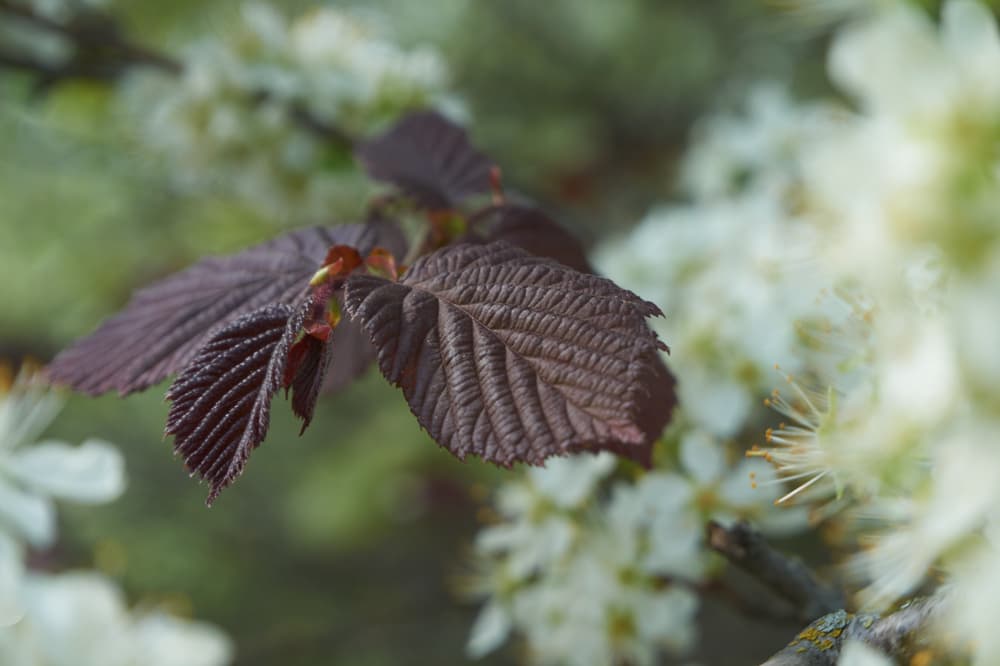
- BOTANICAL NAME: Corylus avellana
- HARDINESS RATING: H6
- FOLIAGE: DECIDUOUS
- RED COLOUR SEASONS: SPRING / SUMMER / AUTUMN
With its profoundly reddish-purple foliage, crinkly textures and interweaving branches, majestic is certainly one name for this showstopper of a shrub.
The way in which its stems twist in and out of one another will certainly add intrigue to your garden, making for a truly unique plant.
The dark tint to its leaves will endure throughout the year, but the arrival of purplish-pink catkins in late winter brings another dimension to its aesthetic appeal.
Capable of reaching as much as 4m in height and the same again in spread, it’s one of the larger shrubs on this list.
However, it will take well over a decade to scale such lofty heights and its slow-growing nature makes it fairly easy to care for, too.
Place it in moist but well-drained soil of almost any composition, and expose it to at least partial (but preferably full) sun and it’ll tend to itself.
2) Japanese Barberry
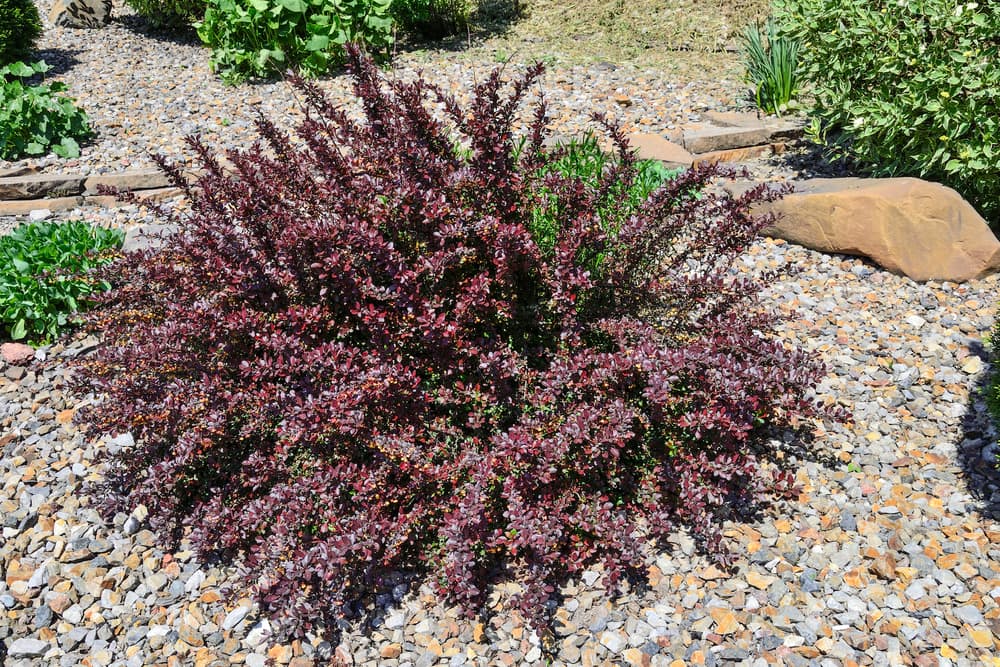
- BOTANICAL NAME: Berberis thunbergii
- HARDINESS RATING: H7
- FOLIAGE: DECIDUOUS
- RED COLOUR SEASONS: SPRING / SUMMER
This genus can be either deciduous or evergreen, but if you opt for the Japanese barberry variety, you’ll be blessed with reds, purples and pinks on its leaves throughout the year.
Come springtime, you’ll even be treated to a spectacular floral display which adds a buttery yellow to the mix.
However, don’t be fooled by its pretty appearance; in spring, the blossoms are accompanied by barbs on its branches, too!
Those spiny thorns mean you must take care when handling or pruning it, but the dramatic flair it brings to your garden (accentuated by the scarlet berries in autumn) are well worth the effort.
It’s largely unfussy about its location in your garden, as long as it’s planted in well-draining soil and given plenty of hydration in its first year.
Once established, it’ll largely fend for itself and can reach a maximum of 1.5m in height, though many never exceed a single metre.
3) Chinese Witch Hazel ‘Burgundy’
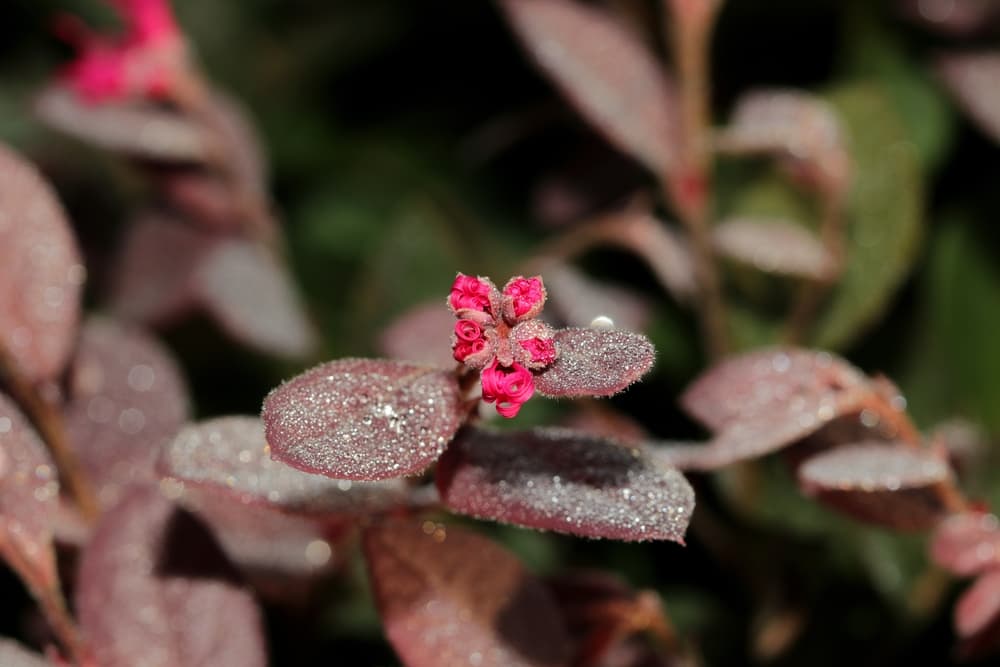
- BOTANICAL NAME: Loropetalum chinense
- HARDINESS RATING: H4
- FOLIAGE: EVERGREEN
- RED COLOUR SEASONS: YEAR-ROUND
From one part of the Orient to another, this Chinese native puts on a transformative show through its foliage throughout its lifetime.
Its leaves begin life with an almost pinkish hue to their rich red, darkening to an olive colour in their advanced years.
What’s more, the plant also boasts impressive floral displays of bright pink blossoms in tassel form in late winter and early spring.
The pleasing contrast of the flowers and the foliage, alongside the delicate perfume that the blooms give off, make it one attractive addition to any garden.
Individual branches on a Chinese witch hazel plant can reach 2m in length, while the overall height and spread of the cultivar can exceed that figure.
For best results, plant the specimen in at least partial shade and fertilise it three times a year to allow it to achieve its maximum potential.
4) Purple-Leaf Sand Cherry

- BOTANICAL NAME: Prunus x cistena
- HARDINESS RATING: H6
- FOLIAGE: DECIDUOUS
- RED COLOUR SEASONS: SPRING / SUMMER / AUTUMN
This delightful specimen is a member of the rose bush family, though that doesn’t mean that its dainty, pinkish-white flowers resemble roses all that closely.
Nonetheless, it’s still a stunning specimen which is guaranteed to bring bags of attraction to your ensemble.
The leaves of this Prunus are, as the common name suggests, of a spectrum which spans every tone from red to purple, encompassing maroons, burgundies and browns and deepening as the year progresses.
When the flowers arrive to offset those tones in springtime, the effect is complete.
The purple-leaf sand cherry normally grows to around a metre (or just over) in height and the same again in spread, making it ideal for filling out a border or injecting some life into a neglected corner.
It’s fairly hardy and self-sufficient, but needs plenty of sunshine and well-draining soil to truly flourish.
5) Red Robin

- BOTANICAL NAME: Photinia x fraseri
- HARDINESS RATING: H5
- FOLIAGE: EVERGREEN
- RED COLOUR SEASONS: SPRING
The leaves of this eye-catching photinia start life as a deep red, thus giving the plant its common name.
However, they do have a tendency to soften into a lusher green in their maturity, but you can always ensure you have plenty of red in amongst your display by pruning back the stems of those which have made the switch.
In addition to the pleasing contrast of green and red that Red Robin boasts, it also features small clusters of white flowers in springtime, completing the Christmassy effect.
The fact that it can grow up to 4m in both height and spread means it’s very popular as a hedge, too.
All in all, it’s a very low-maintenance plant which won’t demand a lot of you in terms of its upkeep.
In the British climate, there shouldn’t be too much need to hydrate it further than natural rainfall, but if you do water it, aim for the soil rather than the foliage.
6) Smoke Bush

- BOTANICAL NAME: Cotinus coggygria
- HARDINESS RATING: H5
- FOLIAGE: DECIDUOUS
- RED COLOUR SEASONS: AUTUMN
Although it takes its name from the clouds of softly pink flowers that really do resemble smoke in summertime, the real draw of Smoke Bush is the foliage.
There are a wide variety of different cultivars which cover the whole spectrum of leaf colours, though all of them are quite spectacular in autumn.
For more year-round red appeal, try ‘Grace’, ‘Royal Purple’ or ‘Golden Spirit’.
The former two have a purplish hue lightening to red in summer, while the latter is characterised by yellow foliage tinted with hints of red.
Whichever one you opt for in the end, you’ll be rewarded with a spectacularly colourful display regardless.
Most Smoke Bush varieties grow to 4m in height and 4m in spread, meaning they’re also widely favoured to create bushes, hedges and other natural boundaries to a property.
You should mulch once a year and expose to full or partial sunshine, but no pruning is needed to maintain its shape.
7) Wine And Roses
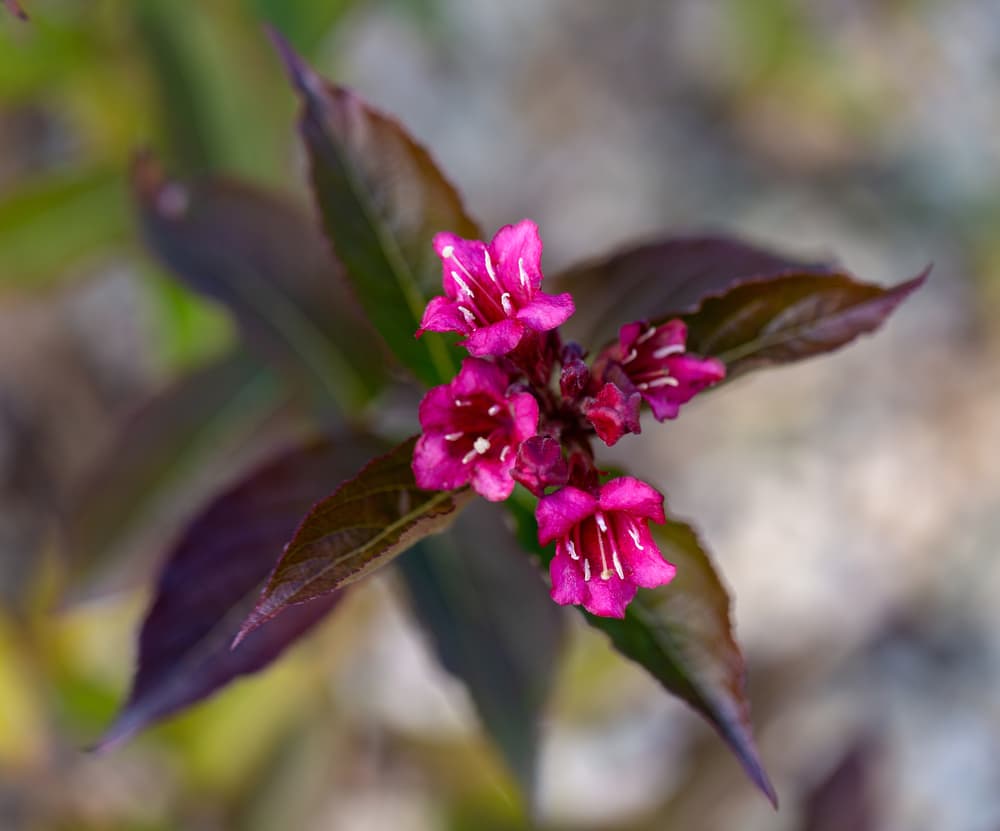
- BOTANICAL NAME: Weigela florida
- HARDINESS RATING: H6
- FOLIAGE: DECIDUOUS
- RED COLOUR SEASONS: SPRING / SUMMER / AUTUMN
Weigela are hugely popular options for beds and borders, given their expansive size, evergreen nature and easy-going temperament.
Wine and Roses is a particularly sought-after option due to the purply-red tint on its foliage, which only becomes more pronounced as the plant matures.
The clusters of pink blossoms, which burst forth in tubular form each spring, add an extra sparkle and sheen to the plant.
Certain plants will even offer a second blooming season in summer, granting you more bang for your buck when it comes to sprucing up your outdoor display.
The plant usually grows just shy of 2m in height and will respond well to aggressive pruning throughout the year, so keep those garden shears sharpened.
It’s largely unfussy about the type of soil it inhabits, so long as it’s fairly fertile and well-draining.
Full or partial sun exposure is required.
8) Ninebark Diabolo
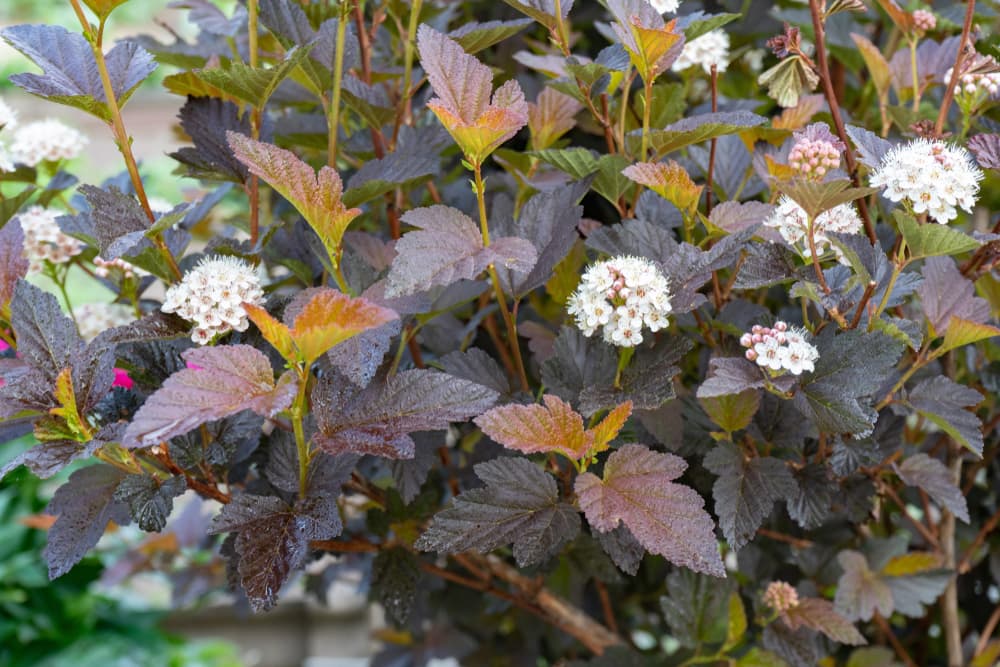
- BOTANICAL NAME: Physocarpus opulifolius
- HARDINESS RATING: H7
- FOLIAGE: DECIDUOUS
- RED COLOUR SEASONS: SPRING / SUMMER / AUTUMN
Okay, okay, okay, so strictly speaking, ninebark diabolo won’t produce red foliage year round.
As a deciduous plant, its leaves are prone to falling away in the depths of the winter, but will remain attractive for the majority of the calendar.
Meanwhile, the deep red bark beneath ensures it’s still visually pleasing even when naked.
As for the leaves themselves, they’re attractively three-lobed customers with a deeply reddish-purple hue.
The texture of the foliage is another point of interest, while the pompoms of delicate white flowers which shoot forth in spring provide a startling contrast to the reds and purples beneath.
It’s slightly faster growing than some of the other options on this list, so it’ll still take the best part of a decade for it to reach its maximum height of 2.5m.
Although it will tolerate alkaline soils, it thrives in acidic ground and may struggle if the chalk content of its terrain is too high.
9) Double Play Big Bang
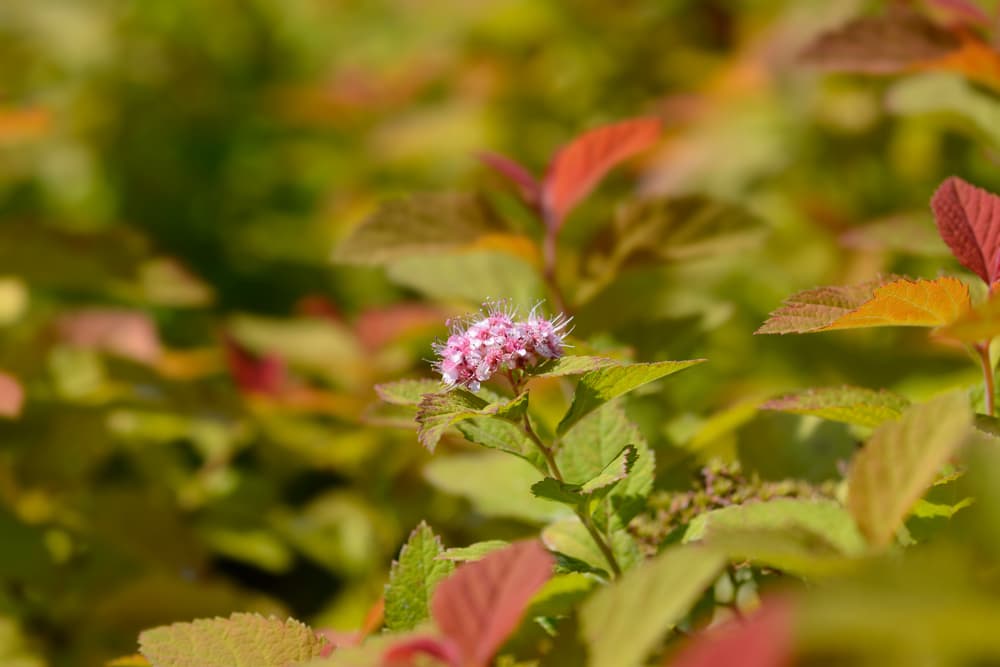
- BOTANICAL NAME: Spiraea japonica
- HARDINESS RATING: H6
- FOLIAGE: DECIDUOUS
- RED COLOUR SEASONS: SPRING / AUTUMN
Fans of an autumnal palette will be particularly pleased with Double Play Big Bang in their outdoor arrangement.
As the mercury in your thermometer rises and falls, so too will the colours of the plant’s foliage oscillate between yellow, orange and red, creating a truly warming tonal effect for your garden.
Again, spiraea are another deciduous shrub whose foliage will fade in the winter months, but the spectacular show they put on for the rest of the year more than compensates for that temporary drop-off.
Meanwhile, the pink blossoms that surface in summer are yet another string to their bow.
They’re on the smaller side of red-leaved shrubs on this list, generally growing to anywhere between 60cm and 90cm.
However, it’s largely trouble-free as long as it’s planted in a sun-facing location that’s blessed with good soil.
In poorer terrain, it may be susceptible to powdery mildew.

